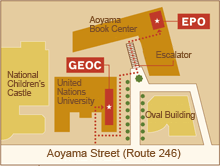Overview
Miyazaki is known for its extended seashell beach along the Pacific with various coastal vegetation and fauna that form a peculiar ecosystem. Even large sea turtles land on the beach to lay eggs. In recent years, however, sand beaches have been suffering from erosion.
In the 1970s and 80s, when intensive industrialization took place, beaches and dunes were viewed as property with low productive value in Japan. Harbors were constructed on the beaches, highways were extended on sand dunes, and hotels and golf courses were developed on the shelter forests. The environments essential to maintain vast beaches were largely altered.
Beach is one of the environments that integrate local community. Conservation strategies therefore require a good discussion among local people, local administrations, and specialists. A civil group, Himuka Sand Beach Network, was launched to advocate addressing beach erosion issues. In order to exchange information with the local administration, it was necessary to understand the current condition of the sand beaches, and the group started investigations. Based on the collected data, the group is proposing provisions for beach conservation. Although forums have been held since three years ago, in which local people and officers attend, discussions fall short to construct conservation strategies. Productive strategies should arise when specialists for environmental science also come to discuss the current environment of beaches.
Points about the partnership
The group holds an annual symposium “Coast of Miyazaki” in cooperation with other organizations involved in coastal conservation. The symposium intends to offer an opportunity for local people to exchange ideas with specialists and authorities.
Category
Based on efforts at ‘co-action’ (cooperative action) by diverse actors
Theme
Biodiversity
Actors
Himuka Sand Beach Network
Partners
Save Sumiyoshi Beach
Relevant information
“Miyazaki-no-kaigan” No. 1 to 9; ISSN 1880-8352
“Sand” Michael Welland, Translated into Japanese by Yumiko Hayashi, Tsukiji Shokan, 2011

















